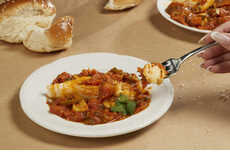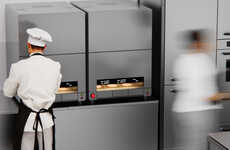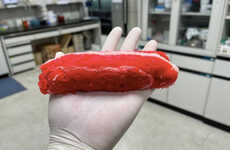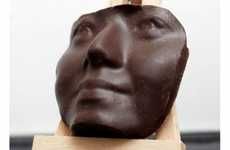3D Bioprinting Technology Allows Living Tissue to be Cloned
Andrew Sztein — January 24, 2013 — Unique
For the super rich and adventurous folks out there, a 3D bioprinting technology-created hamburger will set you back a cool $300,000.
An American startup company called Modern Meadow is using that 3D bioprinting technology to clone living tissue using a 3D printer and ‘bioink’ cartridges that are comprised of animal stem cells. The technology to 3D print simpler ‘dead’ items like plastic or chocolate have existed for a few years, but living tissue is far more complex to recreate. If the technology can really take off, we could actually be looking at a future where meat bought from the butcher didn’t require an animal to be killed to obtain it.
The $300,000 price tag for a single hamburger is a broad estimate given the relative infancy of the technology and scarcity of stem cells for the cartridges. It’s probably safe to assume that as 3D bioprinting technology really takes off, it won’t cost as much as a house for one deliciously cloned hamburger.
An American startup company called Modern Meadow is using that 3D bioprinting technology to clone living tissue using a 3D printer and ‘bioink’ cartridges that are comprised of animal stem cells. The technology to 3D print simpler ‘dead’ items like plastic or chocolate have existed for a few years, but living tissue is far more complex to recreate. If the technology can really take off, we could actually be looking at a future where meat bought from the butcher didn’t require an animal to be killed to obtain it.
The $300,000 price tag for a single hamburger is a broad estimate given the relative infancy of the technology and scarcity of stem cells for the cartridges. It’s probably safe to assume that as 3D bioprinting technology really takes off, it won’t cost as much as a house for one deliciously cloned hamburger.
Trend Themes
1. Bioprinting - 3D bioprinting technology can be used to make living tissue and potentially even whole organs, opening up a market for sustainable clonable meat.
2. Stem Cell Production - The rising demand for advanced healthcare in the future can be met through the improved production of bioink cartridges that contains animal or even human stem cells for tissue engineering and transplants.
3. Animal Agriculture Disruption - Bioprinted food could transform the food industry and reduce the environmental impact of meat consumption by completely replacing traditional animal agriculture.
Industry Implications
1. Food Technology - The food industry has an opportunity to create more ethical, sustainable, and scalable meat alternatives using 3D bioprinting technology.
2. Healthcare - The healthcare industry can leverage 3D bioprinting technology to produce customized, functional, and biocompatible tissues and organs for medical testing and transplantation.
3. Environmental Sustainability - The agriculture industry can reduce its carbon footprint and promote sustainability by exploring alternative protein sources like bioprinted meat.
3.1
Score
Popularity
Activity
Freshness






















